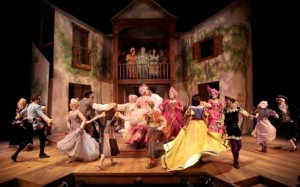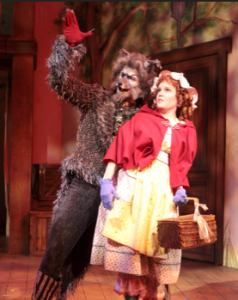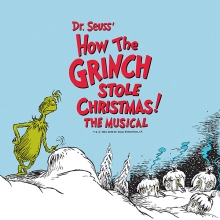Filichia Features: Into Some NEW Woods Part 2
Filichia Features: Into Some NEW Woods Part 2
CM presents Into The Woods. Photo by Mark Lyons.
Last week, when we left the characters after Act One of in Into The Woods at the University of Cincinnati-Conservatory of Music, they were thrilled because they were sure that the worst was behind them. Now what else could happen but their living happily ever after?
The Baker and his Wife were expecting the child for which they’d yearned. Both Cinderella and Rapunzel had married very well and had the lives of princesses ahead of them. Jack had killed the Giant and had appropriated his golden harp. Little Red Riding Hood had a nice new fashionable stole made from a dead wolf.
Ah, but happiness can be fleeting, can’t it? The second act – certainly the more serious of the two – showed us what Sky Masterson had learned years earlier in Guys and Dolls: “I’m healthy at the moment. It can change.”
In Act Two, we reunite with The Baker his Wife after the birth of their child. As any parent can tell you, that can result in some tension between parents on how to raise a kid.
The Wife wants a bigger house, too. But even now, she’s better off than Little Red Riding Hood, whose house is accidentally destroyed. Lawson Young, a freshman at the school, seemed as surprised as any of us who somehow feel immune to such disasters. Don’t they only happen to other people?
Jack finds that life after a thrilling adventure can be a little on the dull side. That’s the way that the Princes who respectively wed Cinderella and Rapunzel now find married life, too. Cinderella is content, yes, but that’s not the same as being genuinely happy. Sitting home all day makes her bored, so she needs to find something to do with her life. “The time has come for a festival,” she decrees. (Let’s hope she means an arts festival; that would really do wonders for the townspeople’s education, state-of-mind, well-being – and happiness.)
Photo by Mark Lyons.
Even Cinderella’s stepsisters, who were blinded by birds as retribution for the terrible way they’d treated Cinderella, sing, "We're so happy you're so happy." At first glance, their reaction may seem psychologically invalid; why would blind sisters revel in the success of a stepsister they’d once scorned? But some people DO act this way: pretend to put their real feelings aside, make the best of a bad situation, treat a former adversary as a hero and live vicariously.
On the other hand, the line could be sung by Cinderella’s stepsisters and stepmother with sarcasm slathered over all eight syllables. That’s what CCM director Aubrey Berg opted for, and it did turn out to be a valid alternative.
As mentioned in last week’s column, this Into the Woods was performed on a stage that replicated Shakespeare’s Globe Theatre -- a three-sided structure that sported six openings, including a wide set of wooden doors at the bottom of stage left and a small Romeo-and-Juliettish balcony above stage right. I emphasize those two, for that’s where Berg decided have the Giant appear. The double-width doors were suddenly slammed to the ground, and we saw an enormous evil eye that made Audrey II at her most powerful look like Toto. Moments later, on that balcony, the Giant’s finger burst in – about eight feet’s worth of finger. Yes, when this Giant pointed a finger at someone, she really pointed it.
Berg’s imagination didn’t stop at scenery. Both he and Victoria Cook, the senior who portrayed the Witch, put their own spin on the character. Too often, a performer will listen to an original cast album, watch the video – and then replicate the performance down to each intonation and gesture. How wonderful to see a performance that borrowed nothing from Bernadette Peters’ original. Many of us can still hear in our heads Peters’ snarl of “Who cares?!” when the Baker and his Wife discussed the runaway cow, or her astonishment at “The giant is a woman!” or her admonition that all should “Wake up!” Cook may have known them all, too, but a theatergoer would have never thought it from her vividly different take on each line. Both Berg and Cook are to be commended for finding new nuances and values. Theater must be a living breathing thing, and not a pale photocopy.
The director was also wise to give the two princes distinctly different personalities. True, they’re usually played as interchangeable, as if they were made from the same cookie-cutter. Granted, there is fun to be had in seeing how bland and ordinary they are. But while Berg retained Rapunzel’s Prince as, to quote a Sondheim line, “a manly little fellow” he opted to make Cinderella’s Prince, to quote a long-forgotten disgraced vice-president, “an effete impudent snob.”
The latter interpretation allowed senior John Riddle to be glorious in acting vaingloriously. He never crossed the line into being effeminate, but he did have the occasional fluttery arm and mincing step. There was also a moment when he was speaking to his brother, noticed a little piece of shmutz on the guy’s jacket and picked it off. After the performance, I asked Riddle if that piece of business was Berg’s idea or his own. He said it with something that he and castmate Matthew Amira had worked out – which proves a good point: the more specifically a director guides his actor into a certain characterization, the more aspects of that character the performer will find.
The script has always had Jack’s Mother act intrepidly when confronting the Giant, even as the other characters worry that her brass-tacks accusations may incite the ogre to terrible revenge. That’s why the Steward takes the liberty of hitting her on the head and (purposely or accidentally?) killing her. As I saw Cassie Levine stand perfectly still in death, I smiled – as I remembered a conversation I’d had years ago with Barbara Bryne, who’d originated the role.
 Bryne told me that she was on her way to one of the final rehearsals before the company would travel to San Diego for the tryout. “But I slipped in Grand Central Station, and went straight down on my right knee,” she said. “I was moaning so loud that people were looking me suspiciously. I called my doctor, who sent me to an orthopedic surgeon. He told me that my leg mustn’t be bent at all, and so it would have to be in a splint. I felt a little silly even asking if he thought I could do the show, and was surprised when he said that I could – but that I would absolutely positively have to use a walking stick. I thought, ‘This is the end.’ But when I talked to (bookwriter-director) James Lapine, he said, ‘I’d really like you to do it, so use a crutch.’”
Bryne told me that she was on her way to one of the final rehearsals before the company would travel to San Diego for the tryout. “But I slipped in Grand Central Station, and went straight down on my right knee,” she said. “I was moaning so loud that people were looking me suspiciously. I called my doctor, who sent me to an orthopedic surgeon. He told me that my leg mustn’t be bent at all, and so it would have to be in a splint. I felt a little silly even asking if he thought I could do the show, and was surprised when he said that I could – but that I would absolutely positively have to use a walking stick. I thought, ‘This is the end.’ But when I talked to (bookwriter-director) James Lapine, he said, ‘I’d really like you to do it, so use a crutch.’”
Ah, when they want you, they really want you. But there was still one more roadblock: when Jack’s Mother would have to fall and die. “And that’s when James said, ‘Well, let’s just have her die and stay standing up.’ Which is exactly what happened. I died with my mouth open and with instant rigor mortis setting in,” she said with a big smile.
A year later, when the show announced that it would open on Broadway, Bryne had fully recovered from her injury. “But,” she says, “James told me not to fall on the floor, for he had come to like me dying standing up – ‘because it’s bizarre, and people do die in bizarre ways.’”
Lord knows how many additional knee injuries have been – because none of the actresses who have since played Jack’s Mother had to fall on the floor. Perhaps you can save your performer’s patella, too, by using this staging. After all, it’s one thing to go into the woods, but another to fall onto the floor.
 Read all of Peter's articles!
Read all of Peter's articles!
You may e-mail Peter at pfilichia@aol.com. Check out his weekly column each Tuesday at www.masterworksbroadway.com and each Friday at www.kritzerland.com. His newest book, Broadway MVPs: 1960-2010 – The Most Valuable Players of the Past 50 Seasons, is now available through Applause Books and at www.amazon.com.



























